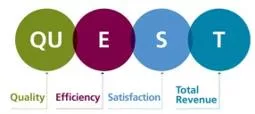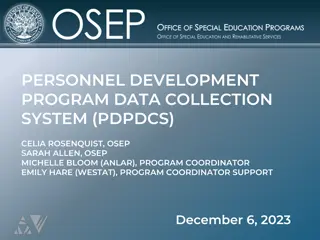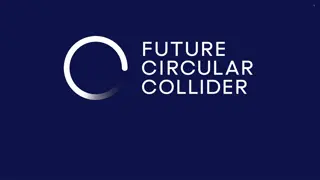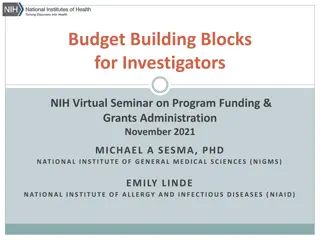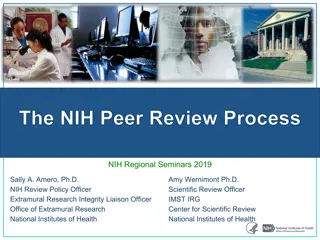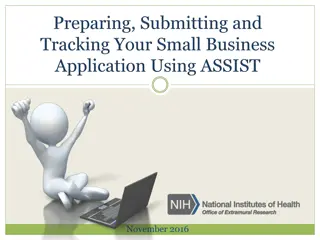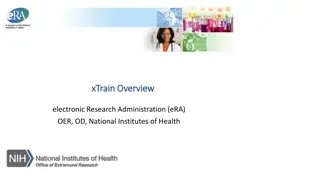Understanding NIH Personnel Roles in Grant Applications
NIH provides guidance on defining personnel roles in grant applications, emphasizing the importance of key personnel designations and ERA Commons IDs. The presentation clarifies requirements for different roles, particularly for PD/PIs and postdoctoral positions, highlighting the necessity of following NIH instructions to prevent proposal rejection. While some aspects may be ambiguous, adherence to explicit guidelines is crucial for successful submissions.
Download Presentation

Please find below an Image/Link to download the presentation.
The content on the website is provided AS IS for your information and personal use only. It may not be sold, licensed, or shared on other websites without obtaining consent from the author. Download presentation by click this link. If you encounter any issues during the download, it is possible that the publisher has removed the file from their server.
E N D
Presentation Transcript
Personnel in NIH Grant Applications A Presentation by Boston Medical Center Research Operations Howie Reith Research Operations Wednesday, 3/21/18 Thursday, 3/22/18
NIH Personnel Primer As a general rule, NIH is more concerned with proper use of the roles they have defined than they are with regulating every possible role you might designate. You can input any role you like by selecting Other on the Personnel screen, and should you do so, the only applicable regulations are those concerning whether your role is Key Personnel. NIH s requirements for personnel roles are thus soft as compared to, say, their requirements for budget item designations. While this frees investigators to be more descriptive in their roles, it can be a source of confusion. 2
NIH Personnel Primer NIH s instructions are also not always entirely clear. Case-in-point: What roles must have ERA Commons usernames included in their profiles at the time of proposal submission? 3
NIH Personnel Primer Answer? An eRA Commons ID is required for all PD/PIs at the time of application. Additionally, an eRA Commons ID is required for anyone in a postdoctoral role and the eRA Commons ID must be reported in the All Personnel Report in the non-competing progress [report] even if the post doc is not senior/key. https://grants.nih.gov/grants/policy/senior_key_personnel_faq s.htm#1681 4
NIH Personnel Primer Don t worry; you haven t been doing all of your applications wrong all these years by not providing Commons IDs for your TBD post-docs. Only PD/PIs need to have ERA Commons user IDs at the time of submission, and this is clarified in the Grants Policy Statement: The Commons user name ID for those with an Undergraduate, Graduate Student, or Postdoctoral Role is not required at the time of application submission, but will be required as part of the Research Performance Progress Report (RPPR). Grants Policy Statement I-44 The latter half of that FAQ thus only refers to Progress Reports, but if you didn t happen to read this paragraph in the GPS, that s hardly obvious from the FAQ s wording. 5
NIH Personnel Primer There are gray areas and awkwardly-worded rules, but there are certain matters on which NIH is clear, and they are the topic of this presentation. While it is possible NIH will tolerate incorrect treatment of roles in our applications, in the matters about which they ve issued explicit instructions, it is in our best interest to adhere to them as closely as possible. Otherwise, we risk a proposal being rejected for administrative reasons, and that would be sad. 6
ROLES 7
What is Key Personnel? (According to the FAQs) The program director/principal investigator (PD/PI) and other individuals who contribute to the scientific development or execution of a project in a substantive, measurable way, whether or not they request salaries or compensation. PD/PI(s) are always considered senior/key personnel and are always named in the Notice of Award (NoA). NIH program officials use discretion in identifying in the NoA senior/key personnel other than the PD/PI(s), and may identify individuals that are considered critical to the project, i.e., their absence from the project would have a significant impact on the approved scope of the project. The prior approval requirement for changes in status of personnel applies only to those senior/key personnel named in the NoA. Limiting the number of individuals that are named in the NoA does not diminish the scientific contribution to the project of the senior/key personnel not named in the NoA; it does reduce the number of individuals subject to the prior approval requirement. https://grants.nih.gov/grants/policy/senior_key_personnel_faqs.htm#1659 8
What is Key Personnel? (According to the Grants Policy Statement) The PD/PI and other individuals who contribute to the scientific development or execution of a project in a substantive, measurable way, whether or not they receive salaries or compensation under the grant. Typically these individuals have doctoral or other professional degrees, although individuals at the masters or baccalaureate level may be considered senior/key personnel if their involvement meets this definition. Consultants and those with a postdoctoral role also may be considered senior/key personnel if they meet this definition. Senior/key personnel must devote measurable effort to the project whether or not salaries or compensation are requested. "Zero percent" effort or "as needed" are not acceptable levels of involvement for those designated as Senior/Key Personnel. -Grants Policy Statement Page I-36 https://grants.nih.gov/grants/policy/nihgps/nihgps.pdf 9
What is Key Personnel? Key Personnel Make a substantive, measurable contribution to the scientific development of the project. (FAQ) If they are named in the NOA (which, aside from the PI who always is, is up to NIH discretion and often not the case), a reduction in effort of >25% will require justification. (FAQ, Grants Policy Statement 8.1.2.6) Must submit biosketches (Grants Policy Statement, FAQ) Must have non-zero effort in all calendar months of the grant. (Grants Policy Statement) In case it helps, to determine whether a participant makes a substantive, measurable contribution to the scientific development, I usually ask PIs, will this person s name appear on any published papers? 10
What about Non-Key Personnel? Significantly less is said about non-key personnel except that we can suppose they are not the things key personnel are expressly described to be. The only explicit item stated about non-key personnel in general is articulated in the FAQ. Regarding biosketches: Do not include them. Biosketches are only required for senior/key personnel and OSC s. https://grants.nih.gov/grants/policy/senior_key_personnel_faq s.htm#1672 11
What is a PD/PI? The PD/PI Is always key personnel. Appears on the NOA and thus must request prior approval to reduce effort on a grant by more than 25%. Must submit a biosketch. Must supply a valid ERA Common username. Must contribute more than 0% effort on all years of the grant. 12
What roles are there besides PD/PI? The roles NIH explicitly acknowledges are few. We have the dropdown menu as it appears in Info-Ed and ASSIST, but those appear to be mostly suggestions. 13
What roles are there besides PD/PI? Co-PD/PI, while a designation used by other sponsors, does not appear in any NIH documentation whatsoever, and NIH explicitly requires other titles in circumstances when such a role might be called for (PD/PI in a multi-PI application, Co- Investigator, or Subaward PI). Faculty does not appear in any documentation. The list includes three variations on Post-Doc and no guidance is provided on when to use each. They appear to be essentially the same. Lastly, of those roles withexplicit definitions, some don t even appear in that drop-down menu. 14
Co-Investigator/Collaborator An individual involved with the PD/PI in the scientific development or execution of a project. The Co-Investigator (collaborator) may be employed by, or be affiliated with, the applicant/recipient organization or another organization participating in the project under a consortium agreement. A Co-Investigator typically devotes a specified percentage of time to the project and is considered senior/key personnel. The designation of a Co-Investigator, if applicable, does not affect the PD/PI's roles and responsibilities as specified in the NIH Grants Policy Statement, nor is it a role implying multiple PD/PI. -NIH Grants Policy Statement page I-13 15
Co-Investigator/Collaborator A Co-Investigator/Collaborator Is always key personnel. May or may not appear on the NOA according to NIH discretion. Must submit a biosketch. Is not required to submit an ERA Commons username at the time of application. Must contribute more than 0% effort on all years of the grant. 16
Other Significant Contributor Individuals who have committed to contribute to the scientific development or execution of the project, but are not committing any specified measurable effort (i.e., person months) to the project. These individuals are typically presented at effort of zero person months or as needed. Individuals with measurable effort may not be listed as Other Significant Contributors (OSCs). Consultants should be included if they meet this definition. -NIH Grants Policy Statement page I-31 17
Other Significant Contributor An Other Significant Contributor Must have zero committed effort. Must submit a biosketch. Is usually significantly involved in the scientific development of the project. 18
Consultants An individual who provides professional advice or services for a fee, but typically not as an employee of the engaging party. In unusual situations, an individual may be both a consultant and an employee of the same party, receiving compensation for some services as a consultant and for other work as a salaried employee. To prevent apparent or actual conflicts of interest, grantees and consultants must establish written guidelines indicating the conditions of payment of consulting fees. Consultants may also include firms that provide paid professional advice or services. https://grants.nih.gov/grants/policy/senior_key_personnel_faqs.htm#1661 Generally, a consultant is not considered senior/key personnel. However, if the consultant contributes to the scientific development or execution of a project substantively and measurably, he/she should be designated as senior/key personnel and would be included in the Senior/Key Person Profile Component. https://grants.nih.gov/grants/policy/senior_key_personnel_faqs.htm#1682 19
Consultants Consultants May or may not be key personnel depending on their scientific contribution to the project. If they are key personnel, their requirements will be consistent with all other key personnel. Are generally compensated via the non-personnel cost Consultant Costs line-item budget, not as personnel in the Personnel section of the budget. Can be Other Significant Contributors, in which case they should be assigned that role. Note that if a consultant is not a BMC employee, is being compensated, and is making a significant contribution to the scientific development of the project (i.e. they are key personnel), this is not a consultant relationship; they must be part of a subaward. 20
Post-Doctoral Associates An individual who has received a doctoral degree (or equivalent) and is engaged in a temporary and defined period of mentored advanced training to enhance the professional skills and research independence needed to pursue his or her chosen career path. This definition is included on the FAQ and is apparently derived from this letter: https://grants.nih.gov/training/Reed_Letter.pdf 21
Post-Doctoral Associates Post-Docs Are usually non-key personnel and thus their biosketches should not be included in applications. They can be considered Key Personnel if they fit the definition (GPS I-36) Must have doctorates. Must be working and training to develop their careers. Must have ERA Commons user IDs provided in progress reports. Note that in the case of Individual Fellowships, the Post-Doctoral and Graduate Student roles should not be used for the Fellow; they are PD/PIs with all requirements associated with that role. 22
Graduate and Undergraduate Students For students, NIH appears to consider their role largely self-explanatory. They offer only two guidelines: Any individual with an Undergraduate, Graduate Student, and/or Postdoctoral Role who participates in a NIH-funded project for at least one person month or more should also be registered in the eRA Commons and should verify that all Personal Information located within the Personal Profile tab in the eRA Commons System is accurate. This is required regardless of whether salary is actually charged to the project. NIH Grant Policy Statement I-44 The maximum amount NIH will award for the support of a graduate student on a research grant or a cooperative agreement is tied to the National Research Service Award (NRSA) zero-level stipend in effect at the time the grant award is issued on the Federal award date. NIH Grant Policy Statement I-57 23
Graduate and Undergraduate Students Graduate and Undergraduate Students Are non-key personnel and thus their biosketches may not be included in applications. Must have ERA Commons user IDs provided in progress reports and their profiles must be up-to-date. May not be compensated in excess of the zero-level stipend level of Post-Docs in F30 grants. The stipend levels for F30 grants are presently available at the following link: https://grants.nih.gov/grants/guide/notice-files/NOT-OD-17-003.html 24
Technicians Technicians only appear in one place in the Grants Policy Statement, stating that they are an allowable cost in a Career Development Award. Salary support for research technicians or study coordinators for clinical studies are generally allowable but are budgeted as part of the Research Development Support Costs described below. NIH Grants Policy Statement IIB-95 Essentially, Technicians are generic non-key personnel. Follow guidelines accordingly. 25
QUIZ 26
Question 1 You have a subcontract PI who is one of the two PIs in a Multi-PD/PI application. What is the proper role for this person? A. PD/PI B. Co-PD/PI C. Multi-PD/PI D. Subaward PI E. None of the above F. This is not allowed 27
Question 2 A member of your faculty is significantly contributing to the scientific development of the project, their name will appear on published papers, and they are being compensated. Which of the following is the most appropriate role? A. Contractor (Key Personnel) B. Other Significant Contributor C. Post-Doc D. Co-Investigator E. None of the above F. This is not allowed 28
Question 3 A recent PhD graduate is working on the project, but the position will likely be filled with several different employees over the five-year life of the grant. Which of the following is the most appropriate role for this person? A. Co-PD/PI B. Post-Doctoral Associate C. Graduate Student D. Research Fellow E. None of the above F. This is not allowed 29
Question 4 You have a consultant who is not a BMC employee but is being compensated off the grant who will be significantly contributing to the scientific development of the application and will appear on published papers. Which of the following is the most appropriate role for this person? A. External Consultant (Non-Key) B. External Consultant (Key) C. Subaward PI D. Other Significant Contributor E. None of the above F. This is not allowed 30
Question 5 A famous and well-regarded physician at BMC will be advising the PI on their work on the project but will not be paid off the grant. This is not a fellowship application. What is the most appropriate role for this person? A. Other Significant Contributor B. Co-Investigator C. Consultant D. Mentor E. None of the above F. This is not allowed 31
Question 6 An investigator at BMC will be significantly contributing to the scientific work in a project, will appear on published papers, and will be compensated, but their effort will fluctuate over the life of the grant, and may disappear entirely. What is the best way to address their role? A. Co-Investigator, Non-Key Personnel, include biosketch B. Investigator, Non-Key Personnel, no biosketch C. Co-Investigator, Key Personnel, include biosketch, make your best guess and justify effort changes in the RPPRs. D. Collaborator, Non-Key Personnel, include biosketch E. None of the above F. This is not allowed 32
Question 7 An employee on the grant will not be significantly contributing to the scientific development of the project. They have a significant career background and their work will not be geared around career development. They are a paid employee of Boston Medical Center. What is the best role to assign this person? A. Co-Investigator B. Other Significant Contributor C. Post-Doctoral D. Consultant E. None of the above F. This is not allowed 33
Question 8 The PI s acquaintance at another hospital will be compensated for running a series of tests on samples collected from subjects at BMC. Their work will be integral to the project but their name will not appear on any published papers. What is the best role for this individual? A. External Consultant (Non-Key) B. Other Significant Contributor C. Subaward PI D. External Consultant (Key) E. None of the above F. This is not allowed 34
Questions? Questions? Comments? 35
BMC Grants Office Info Thank you for attending. Central Email: Todd Erceg: Robina Folland: Howie Reith: Chris Sylvester: Grants.Admin@bmc.org Todd.Erceg@bmc.org Robina.Folland@bmc.org Howard.Reith@bmc.org Christopher.Sylvester@bmc.org 36
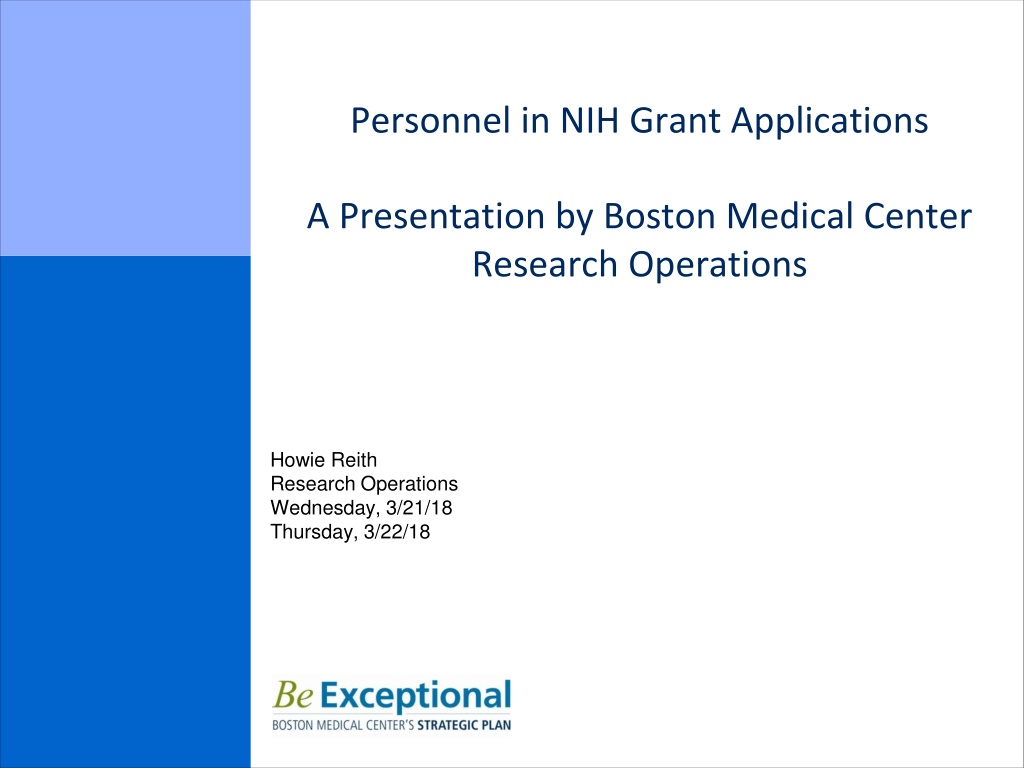
 undefined
undefined





